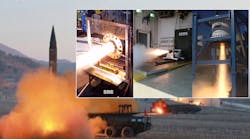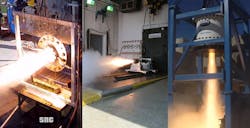OpFires Program Provides Missile Propulsion Advances
Response time is critical when defending against time-sensitive targets and DARPA’s Operational Fires (OpFires) program was established to answer emerging needs for agile defensive weapons systems. The aim of the OpFires program is to develop and demonstrate a ground-launched hypersonic weapon system to engage critical, time-sensitive targets in contested environments, and the program has just completed the preliminary design review of an innovative two-stage tactical missile system.
Early rocket propulsion testing is being performed by Sierra Nevada Corp., Aerojet Rocketdyne, and Exquadrum during Phase 1 of DARPA’s OpFires program. (Courtesy: DARPA)
“U.S. ground-based forces currently are limited in effective range of surface-to-surface precision fires. The goal for OpFires is to provide the combatant commander with options in force deployment and allow persistent standoff from unpredictable land-launch positions,” said the U.S. Army’s Major Amber Walker, program manager for OpFires in the Tactical Technology Office. Spurred by Phase 1 contract awards in Autumn 2018, Aerojet Rocketdyne, Exquadrum, and Sierra Nevada Corp. (SNC) have made significant discoveries in rocket motor technology for the OpFires upper stage, completing more than 30 motor trials. These discoveries put the OpFires program on schedule for booster critical design review by late 2020.
DARPA expects to make additional contract awards by the end of 2019 for the third phase of the OpFires program, which is intended to develop an operational system that employs the propulsion systems developed during the first two phased of the programs. Phase 3 of is expected to conclude with integrated end-to-end flight tests beginning in 2022.


